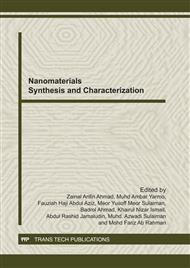[1]
Zhi-Min Dang, LanWang, and Li-Pei Zhang, Surface Functionalization of Multiwalled Carbon Nanotube with Trifluorophenyl, J. Nanomater., Vol. 2006, (2006), 83583, p.1–5.
Google Scholar
[2]
Han-Lang Wu, Chung-Hao Wang, Chen-Chi M. Ma, Yie-Chan Chiu, Meng-Tan Chiang, Chin-Lung Chiang, Preparations and properties of maleic acid and maleic anhydride functionalized multiwall carbon nanotube/poly(urea urethane) nanocomposites, Comp. Sci. Technol., 67, (2007).
DOI: 10.1016/j.compscitech.2006.10.028
Google Scholar
[3]
Marinobu Endo, M. S. Dresselhous, Carbon fibers and carbon nanotubes, (1999), Massachusetts Institute of Technology.
Google Scholar
[4]
Jae-Hyun Choi, J. Jegal and Woo-Nyon Kim, Fabrication and characterization of multi- walled carbon nanotubes/polymer blend membranes, J. Membr. Sci., 284, (2006), p.406 – 415.
DOI: 10.1016/j.memsci.2006.08.013
Google Scholar
[5]
Jae-Hyun Choi, J. Jegal and Woo-Nyon Kim, Modification of Performances of Various Membranes Using MWNTs as a Modifier, Macromol Symp., 249 – 250, (2007), p.610 – 617.
DOI: 10.1002/masy.200750444
Google Scholar
[6]
H. Kuzmany, A. Kukovecz, F. Simona, M. Holzweber, Ch. Kramberger , T. Pichler Functionalization of Carbon Nanotubes, Synth. Met., 141, (2004), p.113–122.
DOI: 10.1016/j.synthmet.2003.08.018
Google Scholar
[7]
Ya-Ping Sun, Kefu Fu, Yi Lin and Weijie Huang, Functionalized Carbon Nanotubes: Properties and Applications, Acc. Chem. Res., (2002), 35, pp.1096-1104.
DOI: 10.1021/ar010160v
Google Scholar
[8]
K. Balasubramanian and M. Burghard, Chemically Functionalized Carbon Nanotubes, Small, Vol. 1, No. 2, (2005) p.180–192.
DOI: 10.1002/smll.200400118
Google Scholar
[9]
Lan Ying Jianga, Tai Shung Chung, Cyclodextrin containing Matrimid® sub-nanocomposite, membranes for pervaporation application, J. Membr. Sci., 327, (2009), p.216–225.
DOI: 10.1016/j.memsci.2008.11.036
Google Scholar
[10]
Jian Chen, Mark J. Dyer, and Min-Feng Yu, Cyclodextrin-Mediated Soft Cutting of Single-Walled Carbon Nanotubes, J. Am. Chem. Soc. (2001), 123 , pp.6201-6202.
DOI: 10.1021/ja015766t
Google Scholar
[11]
S. Samal, K. E. Geckeler, Cyclodextrin-fullerenes: A new class of water-soluble fullerenes. Chem. Comm., (13), (2000), 1101-1102.
DOI: 10.1039/b000710m
Google Scholar
[12]
Fubing Peng, Changlai Hu, Zhiongyi Jiang, Novel poly(vinyl alcohol)/carbon nanotube hybrid membranes for pervaporation separation of benzene/cyclohexane mixtures, J. Membr. Sci., 297, (2007), pp.236-242.
DOI: 10.1016/j.memsci.2007.03.048
Google Scholar
[13]
Kesong Liu, Honggang Fu, Ying Xie, Lili Zhang, Kai Pan, Wei Zhou, Assembly of β-cyclodextrins acting as molecular bricks onto multiwall carbon nanotubes, J. Phys. Chem. C, 112 (4) (2008), pp.951-957.
DOI: 10.1021/jp0756754
Google Scholar
[14]
Lloyd M. Robeson, The upper bound revisited, J. Membr. Sci. 320 (2008) p.390–400.
Google Scholar
[15]
P. Bernardo, E. Drioli, and G. Golemme, Membrane Gas Separation: A Review/State of the Art, Ind. Eng. Chem. Res. (2009), 48, 4638–4663.
DOI: 10.1021/ie8019032
Google Scholar
[16]
David S. Sholl and J. Karl Johnson, Making High-Flux Membranes with Carbon Nanotubes, Science, (2006), Vol 312, pp.1003-1004.
DOI: 10.1126/science.1127261
Google Scholar
[17]
Sangil Kim, Todd W. Pechar, Eva Marand, Poly(imide siloxane) and carbon nanotube mixed matrix membranes for gas separation, Desalination 192 (2006), p.330–339.
DOI: 10.1016/j.desal.2005.03.098
Google Scholar
[18]
Sangil Kim, Liang Chen, J. Karl Johnson, Eva Marand, Polysulfone and Functionalized Carbon Nanotube Mixed Matrix Membranes for Gas Separation: Theory and Experiment J. Membr. Sci., 294, (2007), p.147–158.
DOI: 10.1016/j.memsci.2007.02.028
Google Scholar
[19]
Lu Shao, Yong-Ping Bai, Xu Huang, Ling-Hui Meng, Jun Ma, Fabrication and Characterization of Solution Cast MWNTs/PEI Nanocomposites, J. Appl. Polym. Sci., Vol. 113, (2009), 1879–1886.
DOI: 10.1002/app.30197
Google Scholar
[20]
Sangil Kim, Joerg R. Jinschek, Haibin Chen, David S. Sholl, Eva Marand, Scalable Fabrication of Carbon Nanotube/Polymer Nanocomposite Membranes for High Flux Gas Transport, Nano Lett., 7 (9), (2007), 2806-2811.
DOI: 10.1021/nl071414u
Google Scholar
[21]
Andrei A. Gusev and Olga Guseva, Rapid Mass Transport in Mixed Matrix Nanotube/Polymer Membranes Adv. Mater. (2007), 19, 2672–2676.
DOI: 10.1002/adma.200602018
Google Scholar
[22]
H. Chen, D. S. Sholl, Predictions of Selectivity and Flux for CH4/H2 Separations Using Single walled carbon nanotubes as Membranes, J. Membr. Sci., 269, (2006), pp.152-160.
DOI: 10.1016/j.memsci.2005.06.030
Google Scholar
[23]
Tee J.C., MSc Thesis, Synthesis and Characterization of Multiwalled Carbon Nanotubes on Supported Catalysts via Catalytic Chemical Vapour Deposition, (2006) Universiti Teknologi Malaysia.
Google Scholar
[24]
T. Belin, F. Epron, Characterization methods of carbon nanotubes: a review, Mater. Sci. Eng. B, 119 (2005), p.105–118.
Google Scholar
[25]
Jun Qui, Guojian Wang, Caixia Zhou, Preparation and characterization of amphiphilic multi-walled carbon nanotubes, J. Nanopart. Res, (2008) 10: 659-663.
DOI: 10.1007/s11051-007-9298-3
Google Scholar
[26]
H. Cong, J. Zhang, M. Radosz, Y. Shen, Carbon Nanotube composite membranes of brominated poly(2, 6-diphenyl-1, 4-phenylene oxide) for gas separation, J. Membr. Sci., 274, (2007), 177-185.
DOI: 10.1016/j.memsci.2007.02.035
Google Scholar



